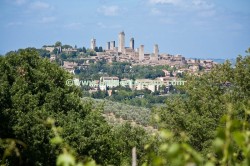Ieškote tikrai išskirtinės vietos Toskanoje? Mūsų išskirtinis pasiūlymas – viduramžiškas Niujorkas Toskanos širdyje – mažasis San Gimignano.
Kaip ir nemažai kitų Toskanos miestelių ant kalvų, pastarasis buvo įkurtas senųjų vietos gyventojų etruskų. Jie čia dominavo 200-300 m. prieš Kristų, na o viduramžiška San Gimignano istorija skaičiuojama nuo maždaug X-ojo amžiaus. Beje, vardą miestelis gavo Modenos vyskupo, šv. Gimignano, dėka – jis išgelbėjo gyvenvietę nuo barbarų puolimų. 1300-aisiais San Gimignano glaudėsi iš Florencijos išvarytas garsusis poetas Dante Alighieri. Na o renesanso laikais čia buvo piligrimų, keliaujančių Via Francigena keliu iš Prancūzijos į Vatikaną, poilsio vieta, tad miestelis ėmė klestėti. Dabar miestukas įtrauktas į UNESCO dėl išlikusios originalios viduramžių architektūros.
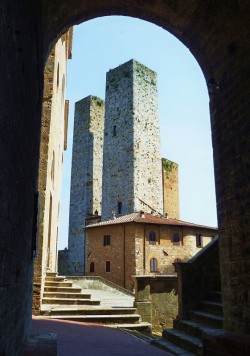 Žavingiausia San Gimignano dalis – bokštai, statyti XI-XIII amžiais, santūrių formų, aukšti ir žemesni, su mažulyčiais langeliais, nebaigti ar apgriuvę – pirklių galios, turto ir prestižo išraiška. Tokių bokštų viduramžiais buvo daugiau nei 70 (o gyveno tik keli tūkstančiai žmonių), ir nė vienas iš jų neturėjo teisės būti aukštesniu už rotušės bokštą (maždaug apie 50 m.). Mažasis San Gimignano turėjo būti panašus į viduramžišką Niujorką. Dabar teliko 15 bokštų, turinčių vardus ir istorijas. Torri Gemelle, arba Bokštai Dvyniai, priklausė bene turtingiausiai San Gimignano šeimai Salvucci, kuri turtus susikrovė iš prekybos. Tad akmeniniai dvyniai buvo puiki priemonė savo susireikšminimui ir egoizmui pademonstruoti. Pagrindiniu Salvucci giminės konkurentu buvo Ardinghelli šeima, užsiiminėjusi prekyba su Lombardijos regionu ir tolimųjų rytų kraštais. Kupini viduramžiško pavydo Ardinghelli giminės nariai nutarė pasistatydinti bokštus dvynius kitoje aikštės pusėje. Tačiau bokštai, kad ir vienas šalia kito – neviendi.
Žavingiausia San Gimignano dalis – bokštai, statyti XI-XIII amžiais, santūrių formų, aukšti ir žemesni, su mažulyčiais langeliais, nebaigti ar apgriuvę – pirklių galios, turto ir prestižo išraiška. Tokių bokštų viduramžiais buvo daugiau nei 70 (o gyveno tik keli tūkstančiai žmonių), ir nė vienas iš jų neturėjo teisės būti aukštesniu už rotušės bokštą (maždaug apie 50 m.). Mažasis San Gimignano turėjo būti panašus į viduramžišką Niujorką. Dabar teliko 15 bokštų, turinčių vardus ir istorijas. Torri Gemelle, arba Bokštai Dvyniai, priklausė bene turtingiausiai San Gimignano šeimai Salvucci, kuri turtus susikrovė iš prekybos. Tad akmeniniai dvyniai buvo puiki priemonė savo susireikšminimui ir egoizmui pademonstruoti. Pagrindiniu Salvucci giminės konkurentu buvo Ardinghelli šeima, užsiiminėjusi prekyba su Lombardijos regionu ir tolimųjų rytų kraštais. Kupini viduramžiško pavydo Ardinghelli giminės nariai nutarė pasistatydinti bokštus dvynius kitoje aikštės pusėje. Tačiau bokštai, kad ir vienas šalia kito – neviendi.
Kairėje Piazza del Duomo aikštės pusėje stūkso Palazzo Comunale rūmai ir laiptai, vedantys iki San Gimignano katedros (it. Basilica Collegiata di Santa Maria Assunta). Priešais – Palazzo dei Ghibellini Salvucci rūmai. Tačiau ryškiausiai dominuoja bokštai-dvyniai. Dešinėje – Palazzo Chigi-Useppi ir Palazzo del Podestà rūmai, kuriuos puošia Torre Rognosa bokštas, kuriame buvo įrengtas kalėjimas.
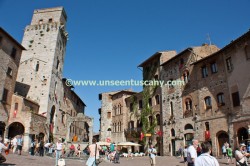 Tačiau pati gražiausia miestelio aikštė – Piazza della Cisterna (liet. Cisternos/šulinio aikštė), žavinti savo nepaprasta architektūra ir autentiška dvasia. Čia nuo seniausių laikų kūrėsi smuklės ir dirbtuvės, o viduryje stunkso aštuonkampis šulinys, pastatytas 1273-aisiais. Šalia Palazzo dei Cortesi rūmų stovi bokštas pavadimu Torre del Diavolo (liet. Velnio bokštas). Pasakojama legenda, kad bokšto šeimininkas, grįžęs į namus po kelionės, rado jį aukštesnį nei paliko ir priskyrė tai velniui. Už kampo yra nedidukė via dell‘Oro gatvė (liet. Aukso gatvė), kurioje buvo įsikūrusios geriausios miestelio auksakalių dirbtuvės.
Tačiau pati gražiausia miestelio aikštė – Piazza della Cisterna (liet. Cisternos/šulinio aikštė), žavinti savo nepaprasta architektūra ir autentiška dvasia. Čia nuo seniausių laikų kūrėsi smuklės ir dirbtuvės, o viduryje stunkso aštuonkampis šulinys, pastatytas 1273-aisiais. Šalia Palazzo dei Cortesi rūmų stovi bokštas pavadimu Torre del Diavolo (liet. Velnio bokštas). Pasakojama legenda, kad bokšto šeimininkas, grįžęs į namus po kelionės, rado jį aukštesnį nei paliko ir priskyrė tai velniui. Už kampo yra nedidukė via dell‘Oro gatvė (liet. Aukso gatvė), kurioje buvo įsikūrusios geriausios miestelio auksakalių dirbtuvės.
Netoli Porta delle Fonti vartų nesunku rasti senovinę skalbyklą, įrengtą čia XIV amžiuje, kur moterys velėjo pageltusias paklodes ir marškinius, pildamos ant jų pelenų ant skalbinių.
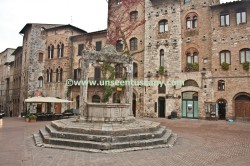 Jei norite iš aukštai pažvegti į San Gimignano panoramą, vietinių dažnai vadinamą anglišku „skyline“ žodžiu, teks keliauti iki Rocca di Montestaffoli. Manoma, kad nuo seniausių laikų čia stovėjo longobardų pilis, vėliau dominikonų vienuolynas, o po jų iškilusioje penkiakampėje tvirtovėje glaudėsi iš kareiviai ir jų kapitonas florentietis. Dabar galima rasti tik vieną iš daugelio tvirtovę supusių bokštelių. Būtent nuo jo atsiveria 360° panorama į miestą ir Valdelsa slėnį. Kitas apžvalgos aikšteles galima rasti keliaujant San Gimignano juosiančia gynybine siena.
Jei norite iš aukštai pažvegti į San Gimignano panoramą, vietinių dažnai vadinamą anglišku „skyline“ žodžiu, teks keliauti iki Rocca di Montestaffoli. Manoma, kad nuo seniausių laikų čia stovėjo longobardų pilis, vėliau dominikonų vienuolynas, o po jų iškilusioje penkiakampėje tvirtovėje glaudėsi iš kareiviai ir jų kapitonas florentietis. Dabar galima rasti tik vieną iš daugelio tvirtovę supusių bokštelių. Būtent nuo jo atsiveria 360° panorama į miestą ir Valdelsa slėnį. Kitas apžvalgos aikšteles galima rasti keliaujant San Gimignano juosiančia gynybine siena.
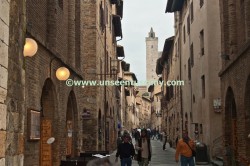 Būtinai prisėskite pagrindinėje San Gimignano gatvelėje esančiame restorane, geriausia – lauke, ir užsisakykite Vernaccia di San Gimignano, baltojo vietinio vyno. Vynas čia gamintas nuo renesanso laikų ir jau tada buvo žymus savo kokybe. Tai buvo ir pirmasis vynas Italijoje 1966-aisiais gavęs DOC statusą, vėliau pakeistą į DOCG (liet. kontroliuotos ir garantuotos kilmės produktas). Vernaccia kvapas vaisiškas, o skonis gaivus ir ypač malonus karštą vasaros popietę.
Būtinai prisėskite pagrindinėje San Gimignano gatvelėje esančiame restorane, geriausia – lauke, ir užsisakykite Vernaccia di San Gimignano, baltojo vietinio vyno. Vynas čia gamintas nuo renesanso laikų ir jau tada buvo žymus savo kokybe. Tai buvo ir pirmasis vynas Italijoje 1966-aisiais gavęs DOC statusą, vėliau pakeistą į DOCG (liet. kontroliuotos ir garantuotos kilmės produktas). Vernaccia kvapas vaisiškas, o skonis gaivus ir ypač malonus karštą vasaros popietę.
Kitas tipiškas vietos produktas – šafranas, – žymus visoje Italijoje. Viduramžiais šis brangus prieskonis buvo ypač svarbus miestelio ekonomikai ir prekybai. XIII amžiuje skolų turėjusi gyvenvietė jas atidavinėjo pusiau pinigais, pusiau šafranu. Vėliau norintieji iš San Gimignano išsivežti šio prieskonio prie miesto vartų turėjo susimokėti „eksporto“ mokestį, nustatytą pagal išvežamo prieskonio kiekį. O šiais laikais San Gimignano šafranas auginamas ekologiškuose ūkiuose, be jokių cheminių preparatų, sėjamas, prižiūrimas ir nurenkamas tik rankomis.
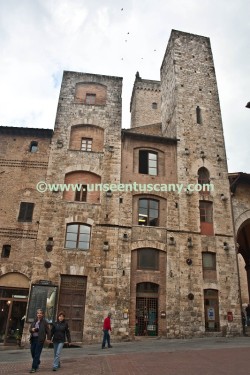 Jei nutarėte įsigyti vietinių produktų, nepamirškite ir alyvuogių aliejaus (it. L’olio extravergine d’oliva di San Gimignano), kuris viduramžiais ir renesanso laikais nebuvo itin paplitęs apylinkėse dėl paprastos priežasties – tai buvo prabangus produktas, sutinkamas tik ant kilmingųjų stalo. Keliaudami pro parduotuvių vitrinas pamatysite pačių įvairiausių kumpių (pvz. Prosciutto Toscano Dop), dešrų (pvz. Finocchiona, Salame toscano) ir kitų mėsos gaminių (pvz. Soprassata, Salsiccioli). Beveik visi šie produktai pagaminti iš vietinės kiaulių rūšies, vadinamos „cinta senese“ (šios kiaulės atvaizdų galima rasti netgi viduramžių freskose ir renesanso paveiksluose!). Nesikuklinkite ir užsukę paragaukite siūlomų produktų – tai nieko nekainuoja!
Jei nutarėte įsigyti vietinių produktų, nepamirškite ir alyvuogių aliejaus (it. L’olio extravergine d’oliva di San Gimignano), kuris viduramžiais ir renesanso laikais nebuvo itin paplitęs apylinkėse dėl paprastos priežasties – tai buvo prabangus produktas, sutinkamas tik ant kilmingųjų stalo. Keliaudami pro parduotuvių vitrinas pamatysite pačių įvairiausių kumpių (pvz. Prosciutto Toscano Dop), dešrų (pvz. Finocchiona, Salame toscano) ir kitų mėsos gaminių (pvz. Soprassata, Salsiccioli). Beveik visi šie produktai pagaminti iš vietinės kiaulių rūšies, vadinamos „cinta senese“ (šios kiaulės atvaizdų galima rasti netgi viduramžių freskose ir renesanso paveiksluose!). Nesikuklinkite ir užsukę paragaukite siūlomų produktų – tai nieko nekainuoja!
Beje, birželį San Gimignano vyksta šventė, vadinama „I Cavallieri di Santa Fina“, kurios metu to paties pavadinimo kultūrinės asociacijos nariai atkuria XIII-ojo amžiaus dokumentuose minėtas miestelio tradicijas minint šv. Finos dieną. Atkuriami keturi istoriniai miesto kvartalai, tarp kurių vyksta raitelių varžybos, šokama, dainuojama ir žaidžiami senoviniai žaidimai.


